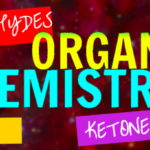Tramadol 50 Mg Buy Today we will be discussing the following topics:
https://www.merlinsilk.com/neologism/ 1. Nomenclature of Aldehydes http://economiacircularverde.com/que-es-la-economia-circular/ and Dialdehydes
Tramadol Online Prices 2. Properties of Aldehydes
https://oleoalmanzora.com/oleoturismo-en-pulpi/ 3. Nomenclature of Ketones, Can You Buy Real Tramadol Online Diketones and Cyclic Ketones
4. Properties of Ketones
5. Nomenclature of Ketenes
6. Properties of Ketenes
Nomenclature of Aldehydes
Aldehydes are organic compounds that have a carbonyl group (carbon double bonded to oxygen) at the end of the chain, so there is only a hydrogen next to the carbonyl.
Because the carbonyl group is on the end of the chain, we don’t need to indicate the number it’s on (we should always start carbon 1 from here). So we name the chain as an alkane, but then take off the ‘e’ and add “anal.” Any substituents would be named at the beginning as usual. Take a look at this example below (I have highlighted the carbonyl group).
We have a 4 carbon chain (butane if we named it as an alkane). Dropping the ‘e’ and adding “anal,” gives butanal. The substituent is a 3-chloro. This is 3-chlorobutanal.

Nomenclature of Dialdehydes
If a compound has two carbonyl groups at the end of both sides of a carbon chain, it will be a dialdehyde. To name these, we use “-dial” as our ending, and name the main chain as an alkane. See this example below. It is a 3 carbon chain (propane, when named as an alkane) and adding the “dial” ending gives propanedial.

Properties of Aldehydes
Properties of aldehydes are the following:
(a) Boiling Points: Boiling points rise as the molecules get bigger. The BP is higher than a fully non-polar compound, but it is lower than that of a shape that can hydrogen bond within itself, such as carboxylic acids and alcohols.
(b) Solubility: They are soluble in water due to the polar carbonyl group. This group can also hydrogen bond with other water molecules (but there is no hydrogen bonding within the shape itself). Longer carbon chains cause decreasing solubility due to being non-polar C-H bonds.
Nomenclature of Ketones
A ketone is almost the same as an aldehyde, but the carbonyl group is in the middle of the chain rather than the end. We will try to number the chain to get the carbonyl group on the lowest number, however if there are other substituents, there is a list of priority groups that I will discuss when solving trickier examples in a later post.
To name a ketone, we put any substituents at the beginning, as always. The name of the main chain is named as an alkane, drop the ‘e’, and add “one.” We also need to indicate the number that the carbonyl group is on, so before “one,” indicate the number.
Take a look at this example below. We have a nine carbon chain, which is “nonane” if we name it as an alkane. Drop the ‘e’ and add “one.” This is nonanone. The carbonyl is on carbon 4. There is a substituent on carbon 2, which is 2-chloro. Putting it together is 2-chlorononan-4-one, or 2-chloro-4-nonanone.

Nomenclature of Diketones
A diketone is a shape that has two carbonyl groups that are not at the ends of the shape. The ending for these shapes is “-dione” (or “trione”, etc depending how many carbonyls are in the shape). Name the main chain as an alkane, indicate the positions of the carbonyls, and add “dione.”
Using the example below, it is a 5 carbon chain. Naming this as an alkane is pentane. Add “dione” to the end, and add the numbers that the carbonyls are on (carbons 2 and 3) at the beginning. This gives 2,3-pentanedione (or pentane-2,3-dione). Any substituents would be named at the beginning of the name, as always.

Nomenclature of Cyclic Ketones
A cyclic ketone is a cycloalkane that has a carbonyl group coming out of the ring directly. To name this, name the regular cycloalkane, drop the ‘e’ at the end, and add “one” to the ending.
Using the example below, this is a 6 carbon ring (start the #1 carbon at the carbonyl). As a cyclic ring without the carbonyl, it would be cyclohexane. Dropping the ‘e’ and adding “-one” gives cyclohexanone. The carbonyl group is on carbon #1, otherwise there would need to be an indication as to its location. You can still put 1-cyclohexanone or cyclohexan-1-one, or just leave it as cyclohexanone because using the 1 is not necessary. Any substituents would be named at the beginning of the name, as always.

Properties of Ketones
Ketones have pretty much the same properties of aldehydes, because they have the same carbonyl group in them.
Nomenclature of Ketenes
Ketenes are the same as ketones, but right next to the carbonyl group they will have a double bonded carbon. This means the carbonyl group ends up being at the end of the chain, but it’s not an aldehyde because there’s no Hydrogen hanging there. The ketene group is highlighted in yellow. This below is an aldoketene because there is a hydrogen on the carbon 2 (the carbon that is a part of the double bond, but doesn’t have the carbonyl on it).

When we don’t have a Hydrogen on carbon 2, but instead have another alkyl group like below, it is called a ketoketene.

To name a ketene, we name the substituents, then put “ketene” at the end of the name. The ketene carbonyl carbon should always be carbon 1.
Take a look at this example below. It is a 5 carbon chain (pentyl if we name that as a substituent) and put ketene at the end. The name is pentylketene.

Properties of Ketenes
These compounds are toxic and colorless. There aren’t a lot of properties online, but if you are aware of one that I should add, let me know in the comments!
